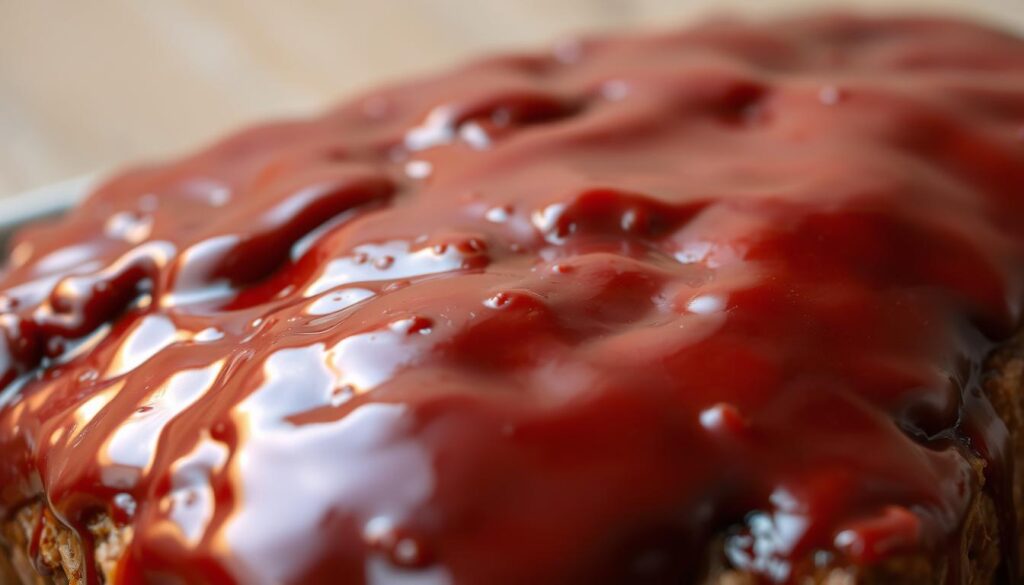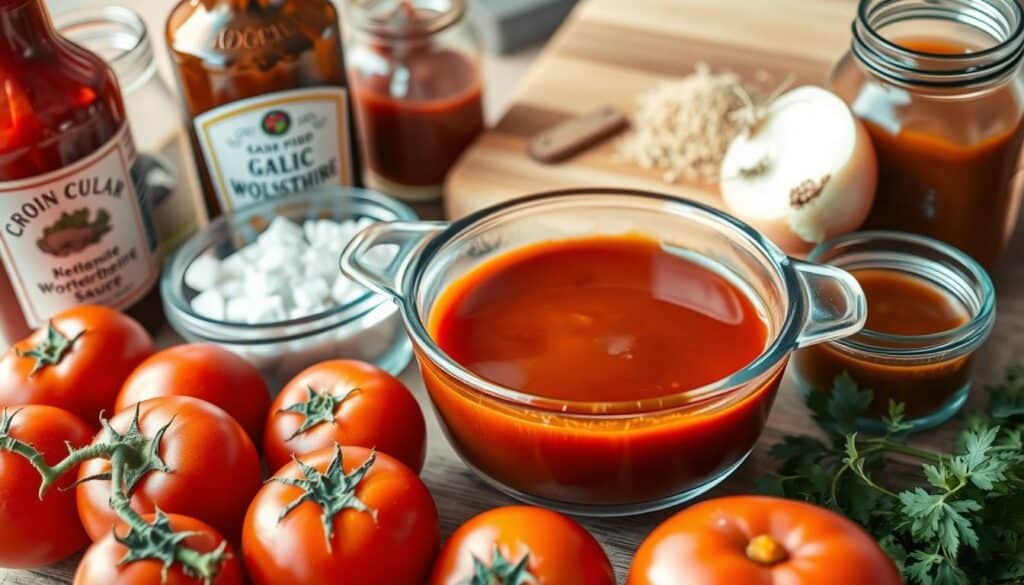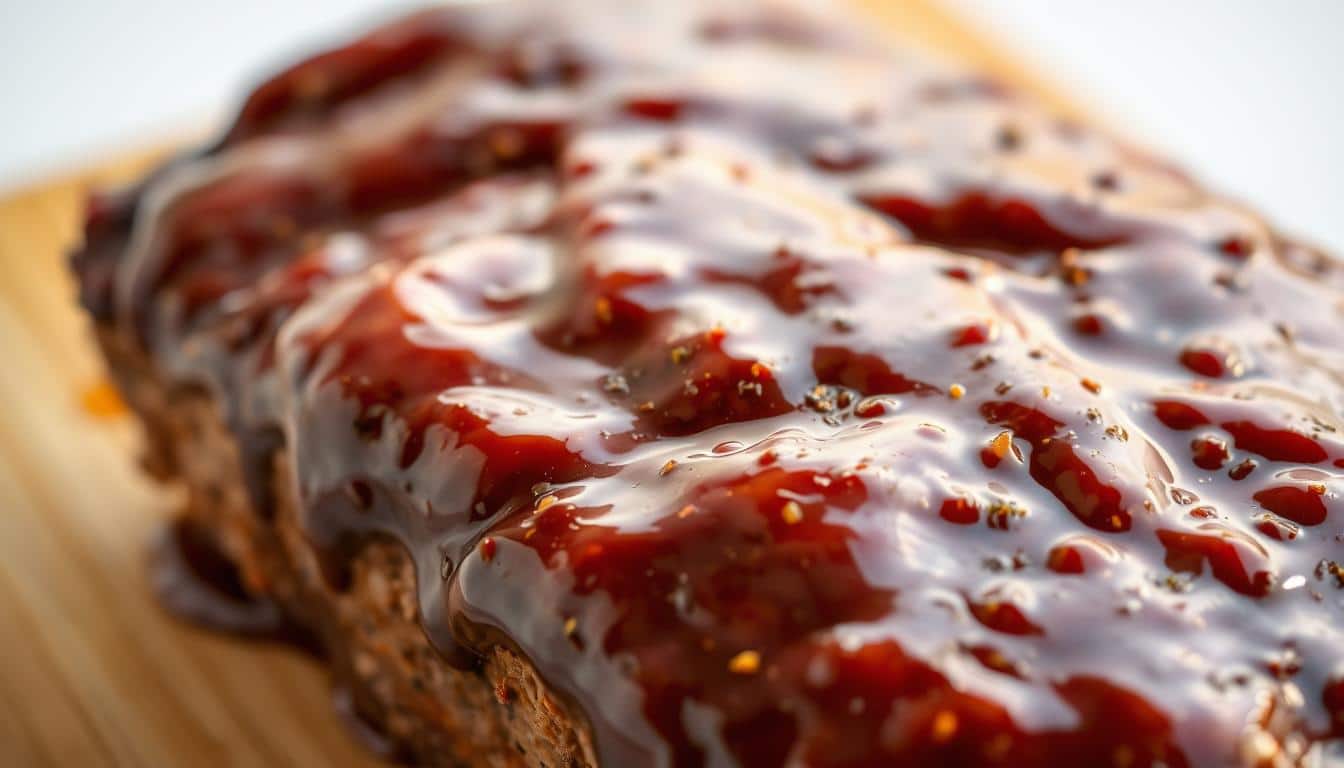Are you tired of serving a dry, flavorless meatloaf to your family and friends? Imagine elevating this classic comfort food with a rich, tangy glaze. This glaze adds depth and complexity to every bite.
The secret is in the perfect balance of ingredients in your meatloaf sauce. A great glaze can transform a good meatloaf into a great one. In this article, we’ll dive into the key elements of a mouth-watering glaze. We’ll also share a favorite meatloaf sauce recipe to try at home.
Table of Contents
Key Takeaways
- Discover the essential ingredients for a perfect glaze
- Learn how to balance flavors for a mouth-watering meatloaf
- Get a simple and delicious meatloaf sauce recipe to try at home
- Understand the importance of glaze in elevating your meatloaf dish
- Explore tips for achieving the right consistency and flavor
The Art of Meatloaf Glazing
Getting the perfect glaze on your meatloaf can turn it into a masterpiece. A great glaze adds flavor and makes the meatloaf look better, making it more appealing.
Why a Good Sauce Makes All the Difference
A good sauce is key for a tasty meatloaf. As one source says, “even the best meatloaf recipe in the world is nothing without a delicious tomatoey glaze to top it off.” The right sauce balances flavors, adds moisture, and creates a caramelized crust that improves the texture.
When thinking about how to cook meatloaf, remember that the sauce is crucial. A well-made sauce can make the dish better, while a bad one can ruin it.
The Science Behind a Perfect Glaze
The perfect glaze is a mix of sugar, acid, and spices. When these are combined correctly, they make a rich, caramelized crust on the meatloaf. The Maillard reaction, a chemical reaction between amino acids and reducing sugars, is what makes this happen.

Knowing the science behind glazing can help make your meatloaf more flavorful. By tweaking ingredients and cooking time, you can get a glaze that’s both sweet and tangy, perfectly matching the meatloaf.
My Favorite Meatloaf Sauce Recipe: Ingredients and Quantities
To make your meatloaf stand out, you need a sauce that’s both tangy and sweet. This is achieved by mixing the right ingredients in the right amounts. Homemade meatloaf sauce is simple yet packed with quality.
Base Ingredients
The base of a great meatloaf sauce includes ketchup, brown sugar, and vinegar. These ingredients set the flavor.
Ketchup (1/2 cup)
Ketchup is the sauce’s base, adding a tangy flavor. Using 1/2 cup gives a strong tomato taste without being too much.
Brown Sugar (1/4 cup)
Brown sugar adds sweetness and depth. The 1/4 cup amount is just right, balancing the sauce.
Vinegar (2 tablespoons)
A 2-tablespoon amount of vinegar, like apple cider or white, cuts through the meatloaf’s richness. It enhances the flavor.
Flavor Enhancers
Flavor enhancers add complexity to your meatloaf sauce. These include Worcestershire sauce, mustard, and spices.
Worcestershire Sauce (1 tablespoon)
Worcestershire sauce adds a savory, umami taste. Just 1 tablespoon makes a big difference.
Mustard (1 tablespoon)
Adding 1 tablespoon of mustard, like Dijon or yellow, brings a tangy, spicy note. It complements the sweetness and richness.
Spices (to taste)
Adding spices to taste lets you customize the sauce. Garlic powder, onion powder, and paprika are popular choices.
Optional Add-ins for Extra Flavor
For extra flavor, consider adding bourbon or chopped herbs. These can enhance your meatloaf sauce.
| Ingredient | Quantity | Purpose |
|---|---|---|
| Ketchup | 1/2 cup | Base flavor |
| Brown Sugar | 1/4 cup | Sweetness and depth |
| Vinegar | 2 tablespoons | Balances richness |
| Worcestershire Sauce | 1 tablespoon | Umami flavor |
| Mustard | 1 tablespoon | Tanginess and spice |
| Spices | To taste | Personalization |

Equipment You’ll Need for Perfect Sauce Preparation
To get a perfect glaze, you need the right kitchen equipment. Having the right tools makes preparing your meatloaf sauce easier and faster.
Basic Kitchen Tools
You’ll need basic tools to start. These include a mixing bowl, a whisk, and measuring cups. They help you mix your ingredients well and accurately.
| Tool | Purpose |
|---|---|
| Mixing Bowl | Combining ingredients |
| Whisk | Blending sauce to desired consistency |
| Measuring Cups | Accurate measurement of ingredients |
Optional Equipment for Advanced Techniques
For advanced techniques, think about using a blender or food processor. They help make your glaze smoother. A strainer is also handy for removing solids if you want.

Step-by-Step Meatloaf Sauce Preparation
The secret to a mouth-watering meatloaf lies in its glaze. We’re about to dive into making it. Preparing your meatloaf sauce involves several key steps. These steps ensure the final product is both flavorful and visually appealing.
Measuring and Combining Ingredients
To start, you’ll need to measure out the ingredients for your sauce accurately. This includes a mix of ketchup, brown sugar, vinegar, Worcestershire sauce, and spices. The precise quantities can vary based on your recipe. The key is to balance the sweet, tangy, and savory flavors. Combine these ingredients in a bowl, stirring until they’re well mixed.
For a basic recipe, you might use:
- 1/2 cup ketchup
- 1/4 cup brown sugar
- 2 tablespoons apple cider vinegar
- 1 tablespoon Worcestershire sauce
- 1 teaspoon smoked paprika
- Salt and pepper to taste
Cooking the Sauce to Perfection
Once your ingredients are mixed, it’s time to cook the sauce. Pour the mixture into a saucepan and place it over medium heat. Bring the sauce to a simmer, then reduce the heat to low. Allow it to cook gently for about 5-7 minutes. This process helps to thicken the sauce and meld the flavors together.
Adjusting Consistency and Flavor
After cooking, assess the sauce’s consistency and flavor. If it’s too thick, you can thin it out with a little water. If it’s too thin, continue to simmer it for a few more minutes until it reaches your desired consistency. Taste the sauce and adjust the seasoning as needed. You might want to add more sugar, vinegar, or spices to get the flavor just right.
Cooling and Storing Your Sauce
Once your sauce is prepared and adjusted, let it cool to room temperature. This step is crucial before storing it. It prevents condensation inside the storage container, which could lead to spoilage. You can store your meatloaf sauce in an airtight container in the refrigerator for up to a week or freeze it for longer storage.
| Storage Method | Duration |
|---|---|
| Refrigerate | Up to 1 week |
| Freeze | Up to 3 months |
Applying Your Sauce to Meatloaf
To get a perfectly glazed meatloaf, apply your sauce at the right time and way. This boosts flavor and looks.
When to Apply the Glaze
Timing is key when glazing. Apply it in the last 30 minutes to 1 hour of cooking. This lets the sauce caramelize and stick well.
If your meatloaf sauce recipe has a lot of sugar, apply it in the last 20 minutes. This prevents burning.
Techniques for Even Application
For an even coat, use a silicone brush or basting brush. Start at the top and go around the meatloaf. Make sure to cover all surfaces.
For a uniform glaze, rotate the meatloaf while applying the sauce.
| Application Technique | Benefits |
|---|---|
| Brushing | Easy to control the amount of glaze applied |
| Pouring | Quick and can cover a large area |
| Drizzling | Creates a decorative pattern on top |
Multiple Layers for Maximum Flavor
For deep flavor, apply multiple glaze layers. Start with a light coat in the last 30 minutes. Then, add more coats every 10-15 minutes.
This builds flavor and creates a rich, caramelized crust.
By following these tips on when and how to apply your meatloaf sauce recipe, you’ll get a beautifully glazed meatloaf. It’s sure to impress. These tips are great for both seasoned cooks and beginners.
Meatloaf Cooking Guidelines
Learning to cook meatloaf is all about the right temperature and time. It doesn’t matter if you’re a pro or just starting. Knowing these tips will help you make a perfect meatloaf every time.
Temperature and Time for Different Meatloaf Sizes
The size of your meatloaf affects how long it takes to cook. A 1-pound meatloaf cooks in about 25-30 minutes at 375°F (190°C). But, a bigger meatloaf, like 2-3 pounds, might need 45-60 minutes or more.
Always use a meat thermometer to check the meat’s internal temperature. It should reach 160°F (71°C) for safety.
How Long to Cook a 2 lb Meatloaf
A 2-pound meatloaf usually takes 45-50 minutes to cook at 375°F (190°C). But, this can change based on the shape and your oven. Always check the internal temperature with a meat thermometer to make sure it’s cooked right.
Signs Your Meatloaf is Perfectly Cooked
There are other ways to tell if your meatloaf is done. It should feel firm to the touch and have slightly browned edges. If it’s pulling away from the pan, it’s cooked. Let it rest for a few minutes before slicing to make it more juicy and flavorful.
By following these tips, you’ll make a delicious and safe meatloaf. The most important things are the temperature and letting it rest.
Sauce Variations to Try
Take your meatloaf to the next level with these exciting sauce variations. Whether you’re in the mood for something spicy, sweet, tangy, or internationally inspired, there’s a meatloaf sauce recipe for you.
Spicy Meatloaf Sauce
For those who like a bit of heat, a spicy meatloaf sauce is perfect. You’ll need:
- 1 cup ketchup
- 1/4 cup hot sauce (such as Frank’s RedHot)
- 2 tablespoons brown sugar
- 1 teaspoon smoked paprika
Mix these ingredients. Brush the sauce over your meatloaf during the last 20 minutes of baking.
Honey-Bourbon Glaze
A honey-bourbon glaze offers a sweet and savory flavor. It’s perfect for those who enjoy a richer taste. To make it, combine:
- 1/2 cup honey
- 1/4 cup bourbon whiskey
- 2 tablespoons Dijon mustard
- 1 tablespoon apple cider vinegar
Apply this glaze during the last 15 minutes of cooking. It allows the flavors to caramelize slightly.
Tangy BBQ-Style Sauce
A tangy BBQ-style sauce is great for those who prefer a traditional barbecue flavor. You’ll need:
| Ingredient | Quantity |
|---|---|
| 1 cup BBQ sauce | Base |
| 2 tablespoons apple cider vinegar | Adds tanginess |
| 1 tablespoon Worcestershire sauce | Enhances depth |
Mix these ingredients and apply the sauce during the last 20 minutes of baking.
International Flavor Inspirations
For a unique twist, try international flavors. For example, a Korean-inspired sauce could include Gochujang (Korean chili paste), soy sauce, brown sugar, and garlic. Experiment with different combinations to find your new favorite flavor.
These sauce variations offer a range of flavors to enhance your meatloaf. Feel free to experiment and adjust the ingredients to suit your taste preferences.
Perfect Side Dishes to Serve with Your Glazed Meatloaf
Looking for side dishes to go with your glazed meatloaf? These ideas will make your meal unforgettable. The right sides can elevate a simple dinner into a special occasion.
Classic Pairings
Traditional sides are often the best choice for glazed meatloaf. Mashed potatoes are a comforting classic that pairs well with meatloaf. Boil diced potatoes until tender, then mash with butter, milk, and a pinch of salt and pepper.
Another timeless option is roasted vegetables, like carrots, Brussels sprouts, or broccoli. Toss them with olive oil, salt, and pepper, and roast in the oven until tender and caramelized.
Green beans are also a great choice. You can steam or sauté them with garlic and lemon. These classic pairings offer a familiar and satisfying complement to your meatloaf.
Modern Twists on Traditional Sides
For a modern twist, try updating traditional sides. Sweet potato mash with cinnamon and nutmeg adds a delightful twist to mashed potatoes. Or, grilled asparagus with parmesan cheese and balsamic glaze offers a sophisticated contrast to the hearty meatloaf.
Other modern options include roasted root vegetables with truffle oil or cauliflower gratin with a crunchy breadcrumb topping. These innovative sides add a fresh and exciting element to your meal.
Conclusion
Now you know the secret to a perfect glaze with our favorite meatloaf sauce recipe. A good glaze can make your meatloaf go from ordinary to extraordinary. With the ingredients and quantities we’ve outlined, you’re ready to impress.
The key to a great meatloaf is in the details. From the base ingredients to the optional add-ins, each step adds flavor. By following our guide, you can make a meatloaf sauce that suits your taste.
A well-crafted meatloaf glaze is the perfect finishing touch for a delicious meal. Mastering meatloaf glazing means you’ll create a dish loved by all. So, get creative with your meatloaf sauce recipe and enjoy a perfectly glazed meatloaf.

